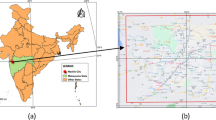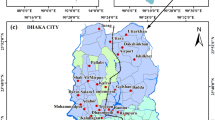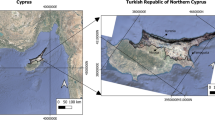Abstract
The world is currently experiencing unprecedented urban growth, industrialization, and the perceived higher standard of living that is often associated with access to better infrastructure. “Surface Heat Island (SHI) is a phenomenon where urban areas experience higher surface temperatures compared to the surrounding rural areas. The presence of the SHI in urban areas in most cases has a negative impact not only on city dwellers, but also on the environment and the economy. This study aimed at evaluating SHI in King Williams Town by studying the relationship between land surface temperatures, land cover and land cover indices. The derived indices are the Normalized Difference Vegetation Index (NDVI) and Normalized Difference Built-up Index (NDBI), these indices were selected because they are representative of the land surface features.” This study was conducted for the King Williams Town (KWT) study area between the years 1995 and 2018, the land surface temperature was derived from Landsat ETM + high thermal band data. The findings from this study provided an idea on the correlation between satellite derived land surface temperature and the land modification, which occurred during the urbanization of King Williams Town during 23-year period between 1995 and 2018. The built-up land category proved to be the most influential or significant in the development of high land surface temperature levels, while vegetation had an opposite effect as a series of data sets illustrated that vegetated areas had a cooling effect on the surface. Water bodies in the study area had insignificant effect on the surface temperature levels while the grass lands were not as cooling as the vegetation but did provide for a cooling environment on the study area.

















Similar content being viewed by others
References
Ahmed B, Kamruzzaman M, Zhu X, Rahman M, Choi K (2013) Simulating land cover changes and their impacts on land surface temperature in Dhaka, Bangladesh. Remote Sens 5(11):5969–5998
As-syakur A, Adnyana I, Arthana IW, Nuarsa IW (2012) Enhanced built-up and bareness index (EBBI) for mapping built-up and bare land in an urban area. Remote Sens 4(10):2957–2970
Bassa, Z. (2013). An assessment of land cover change patterns using remote sensing: a case study of Dube and Esikhawini, KwaZulu-Natal, South Africa (Doctoral dissertation, University of KwaZulu-Natal, Westville)
Busayo ET, Kalumba AM, Orimoloye IR (2019) Spatial planning and climate change adaptation assessment: perspectives from Mdantsane township dwellers in South Africa. Habitat Int:101978
D'Amato G, Cecchi L, D'amato M, Liccardi G (2010) Urban air pollution and climate change as environmental risk factors of respiratory allergy: an update. J Investig Allergol Clin Immunol 20(2):95–102
Debbage N, Shepherd JM (2015) The urban heat island effect and city contiguity. Comput Environ Urban Syst 54:181–194
Donaldson, R. (2001). A model for south African urban development in the 21st century? SATC 2001
Du J, Zhao C, Shu J, Jiaerheng A, Yuan X, Yin J et al (2016) Spatiotemporal changes of vegetation on the Tibetan plateau and relationship to climatic variables during multiyear periods from 1982–2012. Environ Earth Sci 75(1):77
Fall, S., Niyogi, D., Gluhovsky, A., Pielke Sr, R. A., Kalnay, E., & Rochon, G. (2010). Impacts of land use land cover on temperature trends over the continental United States: assessment using the north American regional reanalysis. Int J Climatol, 30(13), 1980–1993
Guo G, Wu Z, Xiao R, Chen Y, Liu X, Zhang X (2015) Impacts of urban biophysical composition on land surface temperature in urban heat island clusters. Landsc Urban Plan 135(1–10):1–10
Gupta, N., Mathew, A., & Khandelwal, S. (2018). Analysis of cooling effect of water bodies on land surface temperature in nearby region: a case study of Ahmedabad and Chandigarh cities in India. The Egyptian Journal of Remote Sensing and Space Science
Harries JE, Brindley HE, Sagoo PJ, Bantges RJ (2001) Increases in greenhouse forcing inferred from the outgoing longwave radiation spectra of the earth in 1970 and 1997. Nature 410(6826):355–357
Khandelwal S, Goyal R, Kaul N, Mathew A (2018) Assessment of land surface temperature variation due to change in elevation of area surrounding Jaipur, India. Egypt J Remote Sens Space Sci 21(1):87–94
Kuenzer C, Dech S (2013) Thermal infrared remote sensing. R Sensing Dig Image Pro 10(1007):978–994
Lawrence DM, Slater AG, Tomas RA, Holland MM, Deser C (2008) Accelerated Arctic land warming and permafrost degradation during rapid sea ice loss. Geophys Res Lett 35(11)
Li ZC, Wei ZG, Wang C, Zheng ZY, Wei H, Liu H (2012) Simulation and improvement of common land model on the bare soil of loess plateau underlying surface. Environ Earth Sci 66(4):1091–1097
Li-An C, Billa L, Azari M (2018) Anthropocene climate and landscape change that increases flood disasters. Int J Hydro 2(4):487–491
Lillesand T, Kiefer RW, Chipman J (2015) Remote sensing and image interpretation. New York: John Wiley & Sons
Liu Q, Yang Z, Han F, Wang Z, Wang C (2016a) NDVI-based vegetation dynamics and their response to recent climate change: a case study in the Tianshan Mountains, China. Environ Earth Sci 75(16):1189
Liu G, Zhang Q, Li G, Doronzo DM (2016b) Response of land cover types to land surface temperature derived from Landsat-5 TM in Nanjing metropolitan region, China. Environ Earth Sci 75(20):1386
Mallupattu PK, Reddy S, Reddy J (2013) Analysis of land use/land cover changes using remote sensing data and GIS at an urban area, Tirupati, India. Sci World J 2013:1–6
Mathew A, Khandelwal S, Kaul N (2018) Analysis of diurnal surface temperature variations for the assessment of surface urban heat island effect over Indian cities. Energ Buildings 159:271–295
Monama TE (2016) Evaluating the urban heat island over the city of Tshwane metropolitan municipality using remote sensing techniques. Doctoral dissertation, University of Johannesburg
Nikam BR, Ibragimov F, Chouksey A, Garg V, Aggarwal SP (2016) Retrieval of land surface temperature from Landsat 8 TIRS for the command area of Mula irrigation project. Environ Earth Sci 75(16):1169
Ogunjobi KO, Adamu Y, Akinsanola AA, Orimoloye IR (2018) Spatio-temporal analysis of land use dynamics and its potential indications on land surface temperature in Sokoto Metropolis, Nigeria. R Soc Open Sci 5(12):180661
Orimoloye IR, Mazinyo SP, Nel W, Kalumba AM (2018) Spatiotemporal monitoring of land surface temperature and estimated radiation using remote sensing: human health implications for East London, South Africa. Environ Earth Sci 77(3):77
Orimoloye IR, Mazinyo SP, Kalumba AM, Ekundayo OY, Nel W (2019) Implications of climate variability and change on urban and human health: a review. Cities 91:213–223
Palme M, Inostroza L, Villacreses G, Lobato-Cordero A, Carrasco C (2017) From urban climate to energy consumption. Enhancing building performance simulation by including the urban heat island effect. Energ Buildings 145:107–120
Pielke RA Sr, Pitman A, Niyogi D, Mahmood R, McAlpine C, Hossain F et al (2011) Land use/land cover changes and climate: modeling analysis and observational evidence. Wiley Interdiscip Rev Clim Chang 2(6):828–850
Ravanelli R, Nascetti A, Cirigliano R, Di Rico C, Leuzzi G, Monti P, Crespi M (2018) Monitoring the impact of land cover change on surface urban Heat Island through Google earth engine: proposal of a global methodology, first applications and problems. Remote Sens 10(9):1488
Ropo OI, Perez MS, Werner N, Enoch TI (2017) Climate variability and heat stress index have increasing potential ill-health and environmental impacts in the East London, South Africa. Int J Appl Eng Res 12(17):6910–6918
SACN. (2015). Open data almanac for cities, Project completed by KPMG, Project Reference: 130:003 for www.sacities.net
Seneviratne SI, Lüthi D, Litschi M, Schär C (2006) Land–atmosphere coupling and climate change in Europe. Nature 443(7108):205–209
Sertel E, Robock A, Ormeci C (2010) Impacts of land cover data quality on regional climate simulations. Int J Climatol 30(13):1942–1953
Silva JS, da Silva RM, Santos CAG (2018) Spatiotemporal impact of land use/land cover changes on urban heat islands: a case study of Paço do Lumiar, Brazil. Build Environ 136:279–292
Sun Q, Wu Z, Tan J (2012) The relationship between land surface temperature and land use/land cover in Guangzhou, China. Environ Earth Sci 65(6):1687–1694
Tarawally M, Xu W, Hou W, Mushore T (2018) Comparative analysis of responses of land surface temperature to long-term land use/cover changes between a coastal and inland city: a case of Freetown and Bo town in Sierra Leone. Remote Sens 10(1):112
Zha Y, Gao J, Ni S (2003) Use of normalized difference built-up index in automatically mapping urban areas from TM imagery. Int J Remote Sens 24(3):583–594
Zhong S, Qian Y, Zhao C, Leung R, Wang H, Yang B, Fan J, Yan H, Yang XQ, Liu D (2017) Urbanization-induced urban heat island and aerosol effects on climate extremes in the Yangtze River Delta region of China. Atmos Chem Phys 17(8):5439–5457
Zhou D, Zhang L, Hao L, Sun G, Liu Y, Zhu C (2016) Spatiotemporal trends of urban heat island effect along the urban development intensity gradient in China. Sci Total Environ 544:617–626
Acknowledgements
Our sincere appreciation goes to “the University of Fort Hare, South Africa for creating an enabling environment for research and United State Geological Survey for providing satellite imageries”.
Author information
Authors and Affiliations
Corresponding authors
Ethics declarations
Competing interests
No competing interests.
Ethical statement
Not applicable.
Additional information
Publisher’s note
Springer Nature remains neutral with regard to jurisdictional claims in published maps and institutional affiliations.
Rights and permissions
About this article
Cite this article
Willie, Y.A., Pillay, R., Zhou, L. et al. Monitoring spatial pattern of land surface thermal characteristics and urban growth: A case study of King Williams using remote sensing and GIS. Earth Sci Inform 12, 447–464 (2019). https://doi.org/10.1007/s12145-019-00391-2
Received:
Accepted:
Published:
Issue Date:
DOI: https://doi.org/10.1007/s12145-019-00391-2




